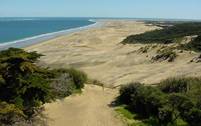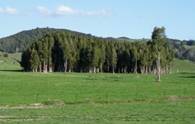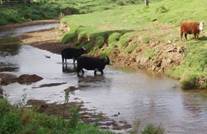15.2 What are the pressures on biodiversity?
Habitat loss
 Habitat loss in Northland over the last 160 years of European settlement includes over 95% of both forests and wetlands. Wetlands and coastal habitats are already under represented and these are the areas that are currently under a lot of pressure. Other areas which are critically under-represented in Northland include volcanic broadleaf forest, riverine floodplain forest, dunelands and gumlands.
Habitat loss in Northland over the last 160 years of European settlement includes over 95% of both forests and wetlands. Wetlands and coastal habitats are already under represented and these are the areas that are currently under a lot of pressure. Other areas which are critically under-represented in Northland include volcanic broadleaf forest, riverine floodplain forest, dunelands and gumlands.
These areas are home to many of the most critically endangered plant and animal species in Northland. Habitat loss does not just occur through vegetation clearance or wetland drainage. Nutrient and sediment run-off into wetlands, lakes and rivers can easily alter the characteristics to the point that conditions are no longer suitable for the species that would be naturally present. Animal pests and weeds can also lead to major habitat modification.
Habitat fragmentation
 As large contiguous areas of indigenous habitat become fragmented due to activities such as land clearance and subdivision their vulnerability to damage from pests, diseases and environmental influences increases and their biodiversity value decreases. Exposed edges provide opportunities for weed species to establish that are then able to invade the forest remnant; small isolated areas are also more vulnerable to wind damage. Isolated fragments may not be large enough or diverse enough to support many species and the isolation from other areas of suitable habitat may prevent the movement of species between areas.
As large contiguous areas of indigenous habitat become fragmented due to activities such as land clearance and subdivision their vulnerability to damage from pests, diseases and environmental influences increases and their biodiversity value decreases. Exposed edges provide opportunities for weed species to establish that are then able to invade the forest remnant; small isolated areas are also more vulnerable to wind damage. Isolated fragments may not be large enough or diverse enough to support many species and the isolation from other areas of suitable habitat may prevent the movement of species between areas.
Fragmentation comes about for a number of reasons. Intensification of land use often involves the clearance of regenerating vegetation such as manuka and kanuka; these areas often buffer and increase the value of adjoining areas of more mature forest. Subdivision of land can also lead to fragmentation as some properties are developed.
Pests and weeds
Northland's warm temperate climate and high rainfall provide conditions that make it vulnerable to a wide range of animal pests and weeds. A wide suite of pests and weeds are already established in the region. A number of pest species such as possums and ferrets have established in Northland relatively recently when compared to other regions of New Zealand, however favourable conditions mean that their numbers have risen rapidly. Northland is vulnerable because of:
· Warm temperate climate;
· An established, wide suite of plant, animal, insect and aquatic pests;
· A predicted climate change forecast which will see the region warming and becoming more dry;
· New organisms are impacting on agriculture, horticulture, the environment and marine ecosystems;
· Declining water quality means that some aquatic ecosystems are more vulnerable to invasive pests.
Disruption of natural processes
A number of native plants and animals are coloniser species or species which occur in sites where natural disturbance such as flooding, wind throw, fire or mass movement of sand or soil are common and sustains these species. In addition all ecosystems and species communities change over time.
There is a poor understanding amongst landowners and land managers of the role of natural habitat dynamics in maintaining biodiversity. Current practises seek to prevent such disturbance and encourage a more stable environment. For this reason many of these species or species communities are now rare and a high proportion of our nationally threatened species are associated with disturbed or regenerating habitats, e.g. Northland green gecko, fernbird, sun orchids and Hebe speciosa. In many parts of the world management techniques using controlled disturbance of habitats containing rare disturbance species are often undertaken as a surrogate for natural disturbance.
Agriculture
 The landscape of New Zealand, including Northland, has been dramatically modified due to developments for agriculture, exotic forestry and horticulture. Much of this change has occurred in the last 160 years. Despite the level of development that has been undertaken many farms in Northland still retain significant remnants of indigenous habitat, more so than many other regions. These areas, though frequently small and fragmented, play an important role in providing habitat for a range of indigenous species and in some cases help to provide corridors that link larger areas of indigenous habitat together.
The landscape of New Zealand, including Northland, has been dramatically modified due to developments for agriculture, exotic forestry and horticulture. Much of this change has occurred in the last 160 years. Despite the level of development that has been undertaken many farms in Northland still retain significant remnants of indigenous habitat, more so than many other regions. These areas, though frequently small and fragmented, play an important role in providing habitat for a range of indigenous species and in some cases help to provide corridors that link larger areas of indigenous habitat together.
A range of government incentives in the 1970's and early 1980's to encourage the development of marginal land for agriculture and forestry resulted in the clearance of large areas of regenerating forest. The withdrawal of subsidies and low commodity prices in the mid-1980's and 1990's saw a lot of these areas again regenerating in either native or exotic woody species such as manuka, kanuka, gorse and woolly nightshade or planted in Pinus radiata. Increasing land prices and commodity prices in the recent years has again led to intensification of landuse and a resulting increase in pressure on indigenous biodiversity.
Agricultural development threatens indigenous habitat and biodiversity in a number of ways. Clearance of indigenous vegetation results in direct loss of biodiversity. Vegetation clearance also leads to habitat and food supply loss for other species. In steeper areas vegetation clearance and grazing development will likely result in increased erosion with resulting detrimental downstream impacts on wetlands and waterways from sediments and nutrients. Where stock have direct access to waterways they reduce water clarity and increase nutrient inputs, which can be detrimental to indigenous flora and fauna.
Where stock have direct access to areas of native forest and indigenous wetlands their presence will impact in a number of ways. Grazing and trampling destroy ground covers and emerging vegetation. Damage to the ground cover creates increased opportunities for exotic weed species to become established. Grazing animals also act as a vector for the transfer of weed species from one site to another. In infertile habitats, such as gumlands, peat bogs and dune lake margins, input of nutrients from stock urine and faecal matter can change the nutrient status of the soils and the composition of associated plant communities.
Climate change
The Intergovernmental Panel on Climate Change (IPCC) presented its fourth assessment in 2007. This report projected that New Zealand's climate is "virtually certain" (greater than 99% probability) to be warmer with noticeable changes in extreme events (IPCC 2007). Heat waves and fire risk are virtually certain to increase in intensity and frequency. Floods, landslides, droughts and storms are likely to become more frequent and intense. Eastern Northland is likely to have lower than average soil moistures.
Natural ecosystems are identified as one of the sectors most vulnerable to these projected changes. Projected rates of climate change are likely to exceed rates of evolutionary adaptation in many species, and habitat loss and fragmentation are very likely to limit species migration in response to shifting climatic zones. Projected changes are likely to increase the threat posed to Northland ecosystems by wildfires, weed species, pest species, storm impacts and reduced water availability. Any sea level rises and increased storm surges will impact on coastal dunes and other coastal ecosystems.
An increase in the frequency of high intensity, short duration rainstorms will result in more slipping and debris avalanches within forested areas. There is an increased risk of these bare areas being re-vegetated by more aggressive weed species than by indigenous colonisers, particularly if the indigenous species are also under stress due to climate change.
